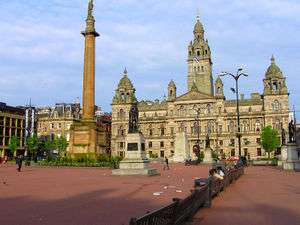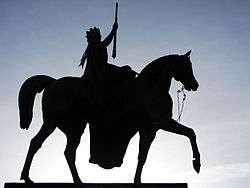Public statues in Glasgow

Public statues in Glasgow, the largest city in Scotland, have been used to display the wealth and history of the city over centuries. The most prominent are those erected by the municipality or by public subscription, but others adorn the façades of the great commercial buildings.
George Square

George Square is Glasgow's central public square, which stands in front of the landmark City Chambers. The square was laid out in 1782, with houses appearing between 1784 and 1820. Many of these later became hotels, especially after the opening of Queen Street Station. Only one of the original houses remains - the Millennium Hotel beside the station. The square is now a magnificent public space dominated by the aforesaid City Chambers, the ex-Post Office, ex-Bank of Scotland and the Merchant's House. During the 19th century, statues to the greatness of Glaswegian, Scottish and British culture were erected. They included poets, adventurers, soldiers, scientists and politicians (local and national), as well as the Queen and Prince Consort. They are all realistic portraits in the 19th century style. They are:
- The Scott Monument - 1837 Column by David Rhind and statue of Sir Walter Scott by John Greenshields carved by Handyside Ritchie.
- The Cenotaph - 1921-24 by Sir J J Burnet Lions and figure of St Mungo by Ernest Gillick, a memorial to the city's fallen in the Great War and other conflicts.
- Thomas Graham, Chemist – 1872 by William Brodie cast by R Masefield and Son of Chelsea
- Thomas Campbell man of letters – 1877 by John Mossman.
- Lord Clyde, Indian Army commander – 1868 by J H Foley.
- Sir John Moore, Peninsular War commander – 1819 by John Flaxman
- Robert Burns, Poet – 1877 by George Edwin Ewing, reliefs by J A Ewing cast by Cox and Son.
- James Watt, engineer and inventor – 1832 by Chantrey.
- Queen Victoria equestrian – 1854 by Baron Marochetti.
- Prince Albert of Saxe-Coburg and Gotha, equestrian - 1866 by Baron Marochetti.
- Robert Peel, Prime Minister – 1859 by John Mossman.
- William Ewart Gladstone, Prime Minister – 1902 by Hamo Thornycroft.
- James Oswald, Member of Parliament – 1856 by Baron Marochetti.
Royal Exchange Square

In Royal Exchange Square outside the Glasgow Gallery of Modern Art and forming an end to Ingram Street is an equestrian statue of the Duke of Wellington by Italian artist Carlo Marochetti, erected in 1844. Capping the statue with a traffic cone has become a traditional practice in the city, claimed to represent the humour of the local population and believed to date back to the first half of the 1980s if not before. The statue is a Category-A listed monument and due to minor damage and the potential for injury that the placing of cones involves, the practice has been discouraged by Glasgow City Council and Strathclyde Police in recent years.[1]
Cathedral Precinct
Cathedral
No pre-Reformation statuary remains on the façade of the ancient Glasgow Cathedral, the city's High Kirk, constructed between 1181 and 1277 and standing as Scotland's largest pre-Reformation church. The cathedral is dedicated to St Mungo (otherwise known as St Kentigern), Glasgow's patron saint. Mungo died in 612 and was buried near his cell by the Molendinar Burn. His shrine remains in the crypt of the cathedral.
There is a portrait head of 'George Bailie, philanthropist' (1873 by J Burnet and John Mossman) on a tomb to west of the south door of the Cathedral.
Cathedral Square
The area in front of the Cathedral is dotted with unremarkable portraits of locally renowned benefactors. However, there is a splendid portrayal of David Livingstone, the famous medical missionary, leaning on a palm tree, below which is a set of discarded leg-irons. On the plinth are pictorial reliefs of grateful natives. It was erected in George Square in 1875-9 and is by John Mossman. It was moved from George Square in 1959.
The other statues are:
- James Lumsden (1778–1856) was a local benefactor. This statue was erected in 1862 and is by John Mossman. Lumsden was Lord Provost of Glasgow from 1843 to 1846 and he is wearing his chain of office. The statue was originally meant to stand at the gates of the Necropolis as a pair to that of James Arthur below.
- James White of Overtoun (1812–1844) was a local employer. This was set up in 1890 and is by John Mossman and finished by Frank Leslie. White was a businessman and lawyer, heavily engaged in philanthropic work.
- James Arthur (1819–1895), was a local businessman – 1893 by G. A. Lawson. This was erected by subscription; among the subscribers were many of his employees.
In the square proper are portrayals of more significant historical personages. In the northwest corner is the Rev Dr Norman Macleod, chaplain to Queen Victoria – 1881-2 by John Mossman and cast by Cox & Son. (The Reverend Doctor is shown on the relief on Queen Victoria's statue in George Square, receiving her to the cathedral on her visit to Glasgow)
In the centre of the square is an impressive equestrian statue of William II of Scotland (William of Orange) as a Roman emperor. It was erected at Glasgow Cross in 1735, at the expense of James Macrae. Macrae had made his fortune in India and had been Governor of Madras. He named his estate near Prestwick 'Orangefields' (now the site of Glasgow Prestwick International Airport)in further homage to his hero King, who was also Prince of Orange. The tail moves in a ball and socket, apparently to prevent it being broken by unruly persons during times of riot. It was moved to its present site in 1923.
St Paul, St Peter and the Four Evangelists, are to be seen on the facade of the Barony North (Glasgow Evangelical) Church to the east of the square – 1878-80 by M’Culloch of London.
Nearby, Glasgow Necropolis, a "garden" cemetery opened in 1833, in imitation of Père Lachaise Cemetery in Paris has a number of statues associated with the funerary monuments of the rich and famous buried there. Most of these are private or religious statues, but the hilltop location is dominated by a large monument to John Knox erected in 1825. It consists of a 12 ft high statue of Knox, designed by Robert Forrest, atop a high Doric column by Thomas Hamilton.
Ingram Street
In Ingram Street is Hutchesons' Hospital, on which are the two oldest statues in Glasgow. They are 17th century statues of the two brothers, taken from the original hospital building. George Hutcheson is pictured on the right. Further along Ingram Street is the Italian Centre displaying rather classical looking modern statues by Alexander Stoddart. Inside the centre a distinctively modern man is rather amusingly struck by the same object of interest as his dog.
Gordon Street
The Citizen Firefighter statue is a bronze sculpture made by sculptor Kenny Hunter and commissioned by the Strathclyde Fire Brigade. The statue depicts a firefighter and represents a tribute to all firefighters past and present who have served in the Strathclyde Fire & Rescue. Three months after it was unveiled (on 17 June 2001) the statue became a focal point for the people of Glasgow to leave flowers and tributes to the firefighters who died in and after the events of Tuesday September 11 in New York.[2]
Woodlands Road

Statue of the cartoon character Lobey Dosser as a tribute to his creator Bud Neill, erected by the citizens of Glasgow. The statue depicts Lobey Dosser, the Sheriff of Calton Creek, taking in his handcuffed arch-enemy Rank Bajin, on his horse El Fideldo (Elfie) which only has two legs. Claimed to be the only two-legged equestrian statue in the world.
Bibliography
- McKenzie, R., Sculpture in Glasgow:an illustrated handbook Glasgow The Foulis Archive Press 1999 ISBN 0-9537149-0-X.
- Williamson, E., Riches, A., and Higgs, M., The Buildings of Scotland: Glasgow Penguin Books London 1990 ISBN 0-300-09674-7.
References
External links
| ||||||||||||||||||||||||||||||||||
